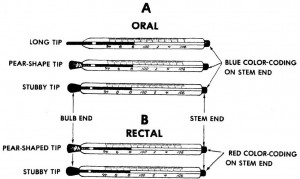a. Glass Oral Thermometers.
(1) The bulb of an oral thermometer is either long tipped, pear-shaped, or stubby (figure 2-5 A ). A long and slender bulb exposes as much surface area of the mercury as possible. Having more surface area exposed helps obtain an accurate temperature quickly.
(2) The other (stem) end of the oral thermometer is colored blue. Color-coding thermometers lets you tell an oral thermometer from a rectal thermometer quickly.

b. Glass Rectal Thermometers.
(1) The bulb of a rectal thermometer is short and thick in order to protect the rectum (figure 2-5 B ). A long, slender bulb tip could accidentally injure the patient by penetrating the walls of the rectum.
A blunt tipped thermometer is much less likely to damage the rectum. Remember, a thermometer with a long and slender bulb is definitely an oral thermometer while a thermometer with a short and thick bulb could be either an oral thermometer or a rectal thermometer.
(2) The stem end of a rectal thermometer is color-coded red. (Remember, the two R’s–red and rectal–go together.)
c. Electric Thermometer Probes.
Electric thermometers come with two different sensing devices (probes). One probe is designated as an oral probe while the other is designated as a rectal probe. The oral probe is color-coded blue while the rectal probe is color coded red. The oral probe and the rectal probe have the same shape and size. The color-coding is simply to prevent a probe from being used to take a temperature rectally one time and a temperature orally the next.
